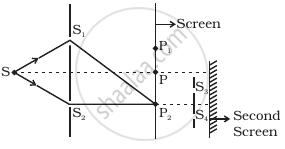Advertisements
Advertisements
प्रश्न
Using Huygens’ principle, verify the laws of reflection at a plane surface.
उत्तर
Verification of Laws of Reflection using Huygens Principle

Consider any point Q on the incident wavefront PA.
When the disturbance from P on incident wavefront reaches point P', the disturbance from point Q reaches Q'
If c is the velocity of light, then the time taken by light to go from point Q to Q' (via point K) is given by,
`t = (QK)/c + (KQ')/c `....(i)
In right-angled ΔAQK,
∠QAK = i
∴ QK = AK sin i
In right-angled ΔKQ'P'
∠Q'P'K = r
`:. KQ' = KP' sin r`
Substituting these values in equation (1),
`t = (AK sin i)/c + (KP'sin r)/c`
`t = (AK sin i + (AP' - AK)sin r)/c` (∵ KP' = AP' - AK)
`t = (AP' sin r + AK(sin i - sin r))/c` ...(ii)
The rays from different points on incident wavefront will take the same time to reach the corresponding points on the reflected wavefront if ‘t’ given by equation (ii) is independent of AK
∴ AK (sin i − sin r) = 0
sin i − sin r = 0
sin i = sin r
i = r
i.e the angle of incidence is equal to the angle of reflection
Also, the incident ray (LA or MP'), reflected ray (AA'L' or P'M'), and the normal (AN) − all lie in the same plane.
APPEARS IN
संबंधित प्रश्न
Using Huygens's construction of secondary wavelets explain how a diffraction pattern is obtained on a screen due to a narrow slit on which a monochromatic beam of light is incident normally.
Use Huygens' principle to verify the laws of refraction.
Use Huygens’s principle to explain the formation of diffraction pattern due to a single slit illuminated by a monochromatic source of light.
With what type of source of light are cylindrical wave fronts associated?
Wavefront means
Figure shows a standard two slit arrangement with slits S1, S2, P1, P2 are the two minima points on either side of P (Figure). At P2 on the screen, there is a hole and behind P2 is a second 2-slit arrangement with slits S3, S4 and a second screen behind them.

Is Huygen’s principle valid for longitudinal sound waves?
According to Huygens's principle, the amplitude of secondary wavelets is ______.
Using Huygen's wave theory of light, show that the angle of incidence is equal to the angle of reflection. Draw a neat and labelled diagram.
Represent diagrammatically how the incident planar wavefronts of wavelength λ pass through an aperture of size d, when d is approximately equal to λ.
